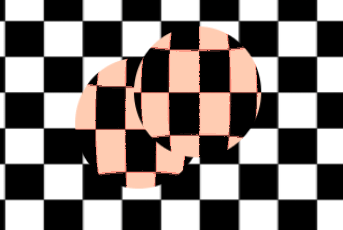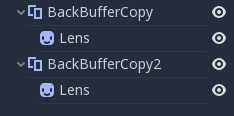Up to date
This page is up to date for Godot 4.2.
If you still find outdated information, please open an issue.
Shaders de lecture d'écran¶
Introduction¶
Très souvent, on souhaite faire un shader qui lit à partir du même écran que celui sur lequel il écrit. Les API 3D, telles que OpenGL ou DirectX, rendent la tâche très difficile en raison de limitations matérielles internes. Les GPU sont extrêmement parallèles, de sorte que la lecture et l'écriture causent toutes sortes de problèmes de cache et de cohérence. Par conséquent, même le matériel le plus moderne ne cela supporte pas correctement.
La solution consiste à faire une copie de l'écran, ou d'une partie de l'écran, dans une mémoire tampon, puis à la lire pendant le dessin. Godot fournit quelques outils qui rendent ce processus facile.
Screen texture¶
Godot Langue de shading has a special texture to access the already
rendered contents of the screen. It is used by specifying a hint when declaring
a sampler2D uniform: hint_screen_texture. A special built-in varying
SCREEN_UV can be used to obtain the UV relative to the screen for the current
fragment. As a result, this canvas_item fragment shader results in an invisible
object, because it only shows what lies behind:
shader_type canvas_item;
uniform sampler2D screen_texture : hint_screen_texture, repeat_disable, filter_nearest;
void fragment() {
COLOR = textureLod(screen_texture, SCREEN_UV, 0.0);
}
textureLod is used here as we only want to read from the bottom mipmap. If
you want to read from a blurred version of the texture instead, you can increase
the third argument to textureLod and change the hint filter_nearest to
filter_nearest_mipmap (or any other filter with mipmaps enabled). If using a
filter with mipmaps, Godot will automatically calculate the blurred texture for
you.
Avertissement
If the filter mode is not changed to a filter mode that contains mipmap in its name,
textureLod with a LOD parameter greater than 0.0 will have the same appearance
as with the 0.0 LOD parameter.
Screen texture example¶
The screen texture can be used for many things. There is a special demo for Screen Space Shaders, that you can download to see and learn. One example is a simple shader to adjust brightness, contrast and saturation:
shader_type canvas_item;
uniform sampler2D screen_texture : hint_screen_texture, repeat_disable, filter_nearest;
uniform float brightness = 1.0;
uniform float contrast = 1.0;
uniform float saturation = 1.0;
void fragment() {
vec3 c = textureLod(screen_texture, SCREEN_UV, 0.0).rgb;
c.rgb = mix(vec3(0.0), c.rgb, brightness);
c.rgb = mix(vec3(0.5), c.rgb, contrast);
c.rgb = mix(vec3(dot(vec3(1.0), c.rgb) * 0.33333), c.rgb, saturation);
COLOR.rgb = c;
}
Dans les coulisses¶
While this seems magical, it's not. In 2D, when hint_screen_texture is first
found in a node that is about to be drawn, Godot does a full-screen copy to a
back-buffer. Subsequent nodes that use it in shaders will not have the screen
copied for them, because this ends up being inefficient. In 3D, the screen is
copied after the opaque geometry pass, but before the transparent geometry pass,
so transparent objects will not be captured in the screen texture.
As a result, in 2D, if shaders that use hint_screen_texture overlap, the
second one will not use the result of the first one, resulting in unexpected
visuals:

In the above image, the second sphere (top right) is using the same source for the screen texture as the first one below, so the first one "disappears", or is not visible.
En 2D, cela peut être corrigé via le nœud BackBufferCopy, qui peut être instancié entre les deux sphères. BackBufferCopy peut fonctionner en spécifiant soit une région de l'écran, soit l'écran entier :

Avec une copie correcte du back-buffer, les deux sphères se mélangent correctement :

Avertissement
In 3D, materials that use hint_screen_texture are considered transparent themselves and
will not appear in the resulting screen texture of other materials.
If you plan to instance a scene that uses a material with hint_screen_texture,
you will need to use a BackBufferCopy node.
In 3D, there is less flexibility to solve this particular issue because the screen texture is only captured once. Be careful when using the screen texture in 3D as it won't capture transparent objects and may capture some opaque objects that are in front of the object using the screen texture.
You can reproduce the back-buffer logic in 3D by creating a Viewport with a camera in the same position as your object, and then use the Viewport's texture instead of the screen texture.
Logique du back-buffer¶
So, to make it clearer, here's how the backbuffer copying logic works in 2D in Godot:
If a node uses
hint_screen_texture, the entire screen is copied to the back buffer before drawing that node. This only happens the first time; subsequent nodes do not trigger this.If a BackBufferCopy node was processed before the situation in the point above (even if
hint_screen_texturewas not used), the behavior described in the point above does not happen. In other words, automatic copying of the entire screen only happens ifhint_screen_textureis used in a node for the first time and no BackBufferCopy node (not disabled) was found before in tree-order.BackBufferCopy can copy either the entire screen or a region. If set to only a region (not the whole screen) and your shader uses pixels not in the region copied, the result of that read is undefined (most likely garbage from previous frames). In other words, it's possible to use BackBufferCopy to copy back a region of the screen and then read the screen texture from a different region. Avoid this behavior!
Texture de profondeur¶
For 3D shaders, it's also possible to access the screen depth buffer. For this,
the hint_depth_texture hint is used. This texture is not linear; it must be
converted using the inverse projection matrix.
Le code suivant récupère la position 3D sous le pixel dessiné :
uniform sampler2D depth_texture : hint_depth_texture, repeat_disable, filter_nearest;
void fragment() {
float depth = textureLod(depth_texture, SCREEN_UV, 0.0).r;
vec4 upos = INV_PROJECTION_MATRIX * vec4(SCREEN_UV * 2.0 - 1.0, depth, 1.0);
vec3 pixel_position = upos.xyz / upos.w;
}
Normal-roughness texture¶
Note
Normal-roughness texture is only supported in the Forward+ rendering method, not Mobile or Compatibility.
Similarly, the normal-roughness texture can be used to read the normals and
roughness of objects rendered in the depth prepass. The normal is stored in the
.xyz channels (mapped to the 0-1 range) while the roughness is stored in the
.w channel.
uniform sampler2D normal_roughness_texture : hint_normal_roughness_texture, repeat_disable, filter_nearest;
void fragment() {
float screen_roughness = texture(normal_roughness_texture, SCREEN_UV).w;
vec3 screen_normal = texture(normal_roughness_texture, SCREEN_UV).xyz;
screen_normal = screen_normal * 2.0 - 1.0;
Redefining screen textures¶
The screen texture hints (hint_screen_texture, hint_depth_texture, and
hint_normal_roughness_texture) can be used with multiple uniforms. For
example, you may want to read from the texture multiple times with a different
repeat flag or filter flag.
The following example shows a shader that reads the screen space normal with linear filtering, but reads the screen space roughness using nearest neighbor filtering.
uniform sampler2D normal_roughness_texture : hint_normal_roughness_texture, repeat_disable, filter_nearest;
uniform sampler2D normal_roughness_texture2 : hint_normal_roughness_texture, repeat_enable, filter_linear;
void fragment() {
float screen_roughness = texture(normal_roughness_texture, SCREEN_UV).w;
vec3 screen_normal = texture(normal_roughness_texture2, SCREEN_UV).xyz;
screen_normal = screen_normal * 2.0 - 1.0;